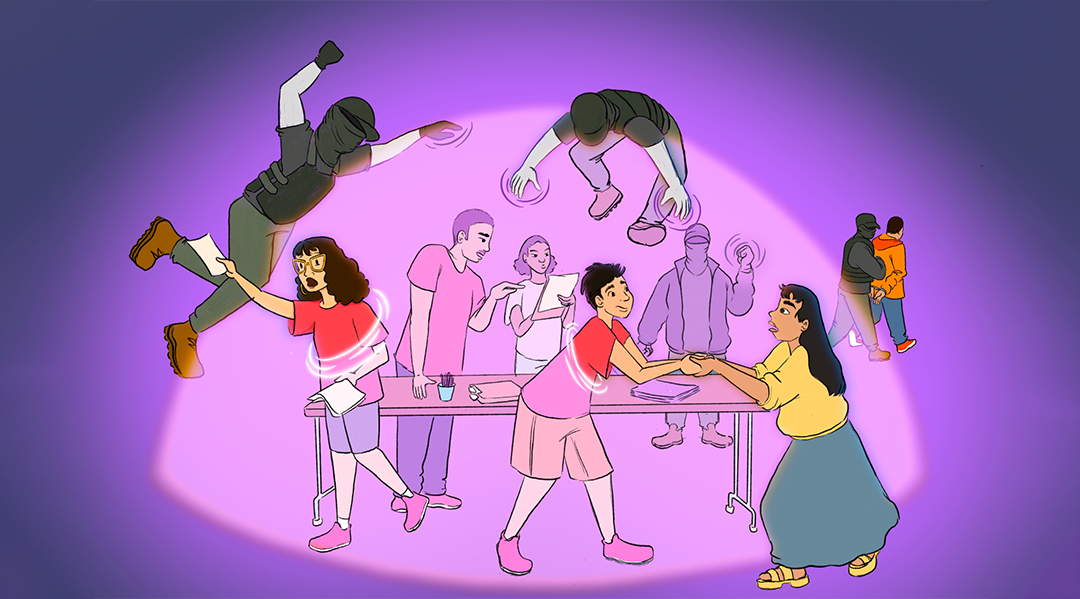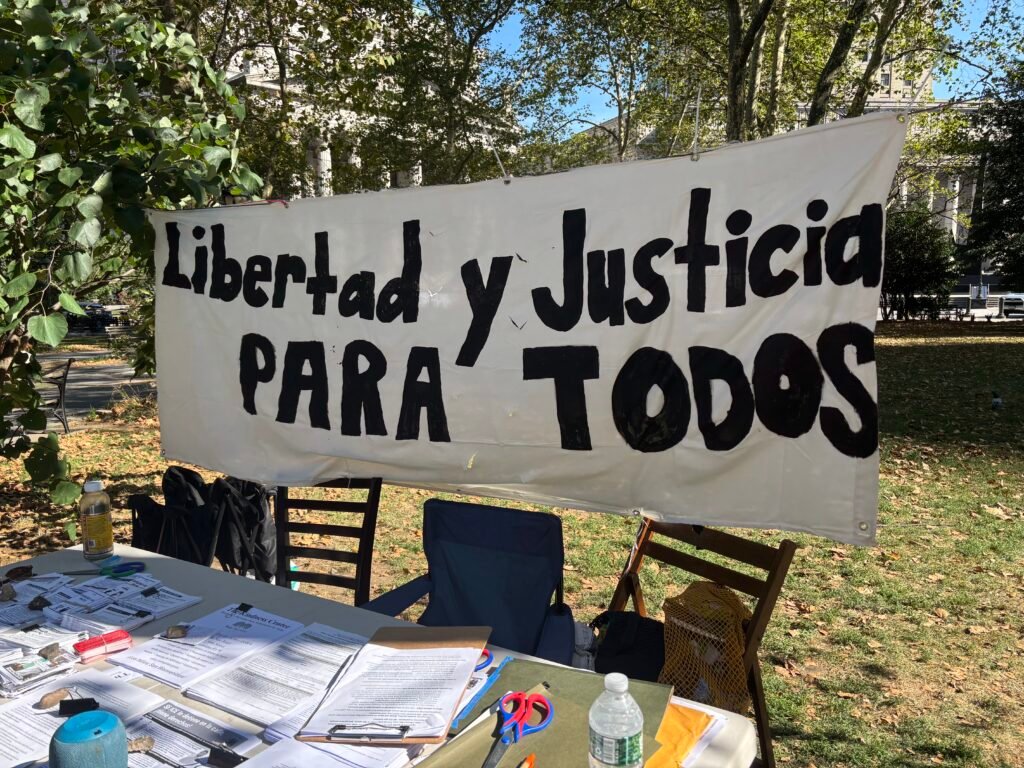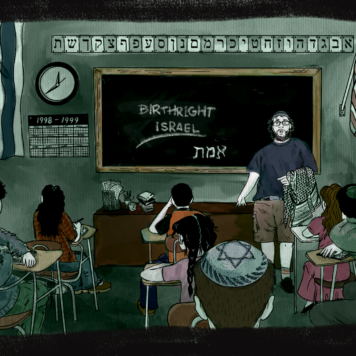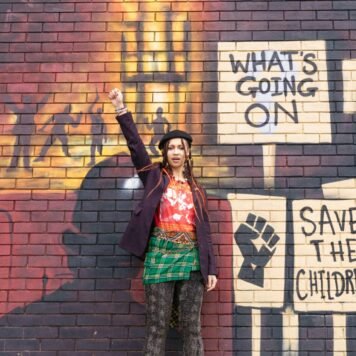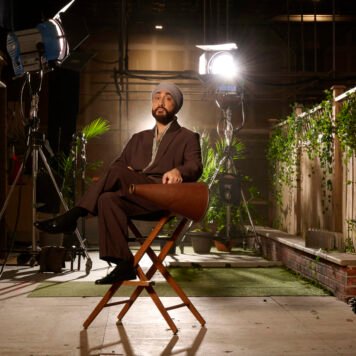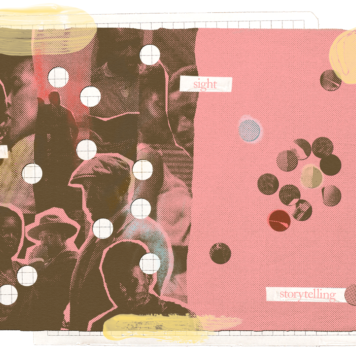It’s 6am on a clear day in Downtown Manhattan, with a brisk wind blowing that smells like early fall. In a corner of Thomas Paine Park, volunteers* are setting up chairs and tables.
They bring fresh, warm food and coffee. Several of them grab wrapped sandwiches and hand them out to people slowing down, curious as to what’s happening.
“Yeah, for free!” they insist. “And while you’re here, do you know your rights?”
This is Liberty City. The brainchild of organisers in the immigration rights space, it’s an entirely volunteer-run “dawn-to-dusk installation” intended to be a home base for on-the-ground ICE resistance in New York City.
I signed up for a volunteer shift at Liberty City after seeing a flyer on social media. From there, with the vouchsafe of a friend and past experience with the movement, I found myself on site that morning.
I speak with S, a volunteer, who invites me to join in her task of meticulously rearranging stacks of “know your rights” literature in multiple languages on a folding table. “We care about intervening directly in the violence of the state,” they explain. “We share resources with community members interacting with the immigration system, and we try to do the care work that the courts and the state would never provide to our neighbours and each other.”
Cloth banners fly between trees with slogans: Libertad y Justicia para todos. Bienvenue, Bienvenidos, Welcome. One rippling sheet has a crisp image of the Statue of Liberty with a line from Emma Lazarus’ “The Great Colossus” – the same words engraved on the real statue’s pedestal just five miles south in New York Harbour: Give me your tired, your poor, your huddled masses yearning to breathe free.
Behind closed doors, the ICE crackdown in courthouses
The defiant slogans are just across the street from 26 Federal Plaza and 290 Broadway, two US federal courthouses. Nearby is a third courthouse, on Varick Street. For years, they have been places where people go to be processed through the US immigration system – yearly check-ins, citizenship interviews and ceremonies, asylum hearings, and more. However, since January, they have been the nexus of federal deportation operations at a scale activists can hardly comprehend.
US Immigrations and Customs Enforcement agents – ICE – have free rein outside of these courtrooms to stop, arrest, and detain people with no oversight. And this abuse has escalated with Trump’s threats to “flood the zone” and deport 1 million immigrants.
In New York, ICE’s approach differs from what it has looked like in other cities, like Los Angeles. When I speak with E, a Liberty City organiser, she describes ICE’s crackdown in Los Angeles and Southern California as “public spectacle” intended to maximise terror.
“People [in California] are very aware of what’s happening because they see it as they drive to work or head to the grocery store. There, the resistance is similarly public,” she says. “But, in New York, it’s different. They are targeting the courts, and the majority of abductions here are happening behind closed doors. There’s less public resistance and awareness. Here, it feels quiet, like it’s not happening.”
Walking to Liberty City in the morning, shoulder-to-shoulder with commuters on the train, past men and women in business casual, the city looked the same as any other morning. Mundane, with mundane worries about gym memberships and whether or not you missed your morning coffee in your rush to leave. The impenetrable glass-and-steel facades of the federal buildings looked unchanged, glowing in the dawn like they always have. It’s hard to imagine that just steps away families were being torn apart.
An impossible Catch-22
Despite appearances, New York City now leads the nation in the number of people arrested in courthouses with half of all immigration court arrests this summer occurring in the city.
Anecdotally, activists report witnessing the abduction of dozens of people in a day at each site over the summer months. As their cases are dismissed or delayed, as they’re in waiting rooms, or they show up for regular check-ins on the weekends, masked agents in bulletproof vests grab them and force them away.
Once snatched, people remain in 26 Federal Plaza, where ICE and DHS are detaining people in abusive and inhumane conditions. Then, they are taken to longer term detention facilities – many of which are owned by private prison companies like GEO Group – companies that are only profitable because of multi-million dollar contracts signed with ICE and DHS. Some of these facilities are across the river in New Jersey or Pennsylvania, others are in Louisiana or Florida, where families struggle to coordinate with lawyers hundreds of miles away.
Immigrants engaging with the system are therefore backed into an impossible Catch-22. Showing up at court or at a check-in means you might be arbitrarily disappeared. Yet, skipping court means violating the conditions for your stay in the United States, and is grounds for deportation.
In this fraught crossroads, activists, lawyers, volunteers, and ordinary New Yorkers aim to fill the gaps – and often find a home base across the street in Liberty City.
An entry point to the movement
Throughout the day, the bold signage attracts onlookers and curious passers-by. The physical installation serves to open public conversation about ICE and immigration – and drags ICE’s crimes out into the light.
Most who stop by are open to engaging, part of what I feel is a conscientious majority that feel driven to help but don’t know how. Volunteers at the table of literature are trained to give them a rundown on the space, the issue, and give them options to plug in and engage.
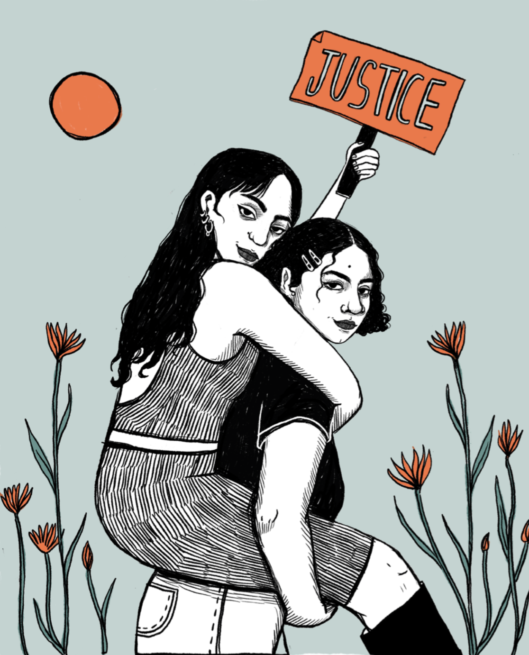
Join our mailing list
Sign up for shado's picks of the week! Dropping in your inbox every Friday, we share news from inside shado + out, plus job listings, event recommendations and actions ✊
Sign up for shado's picks of the week! Dropping in your inbox every Friday, we share news from inside shado + out, plus job listings, event recommendations and actions ✊
A first timer stopping by to learn more explained what drew them to Liberty City: “I kept seeing everything in the news, and every time I saw another mother, father, kid get detained, I just wanted to do something even a little bit meaningful to help. When I talk to other people about [ICE], they say oh, it sucks. But it doesn’t just suck, like, oh I got my coffee order wrong. It should be devastating.”
Liberty City fills a gap in the “thoughts and prayers” inaction so commonplace in the American political system. As New Yorkers are moved to do something, outlets like Liberty City give them direction as they begin to exhaust other opportunities of trying to dissent in a system that, as a bandana-ed volunteer puts it, “couldn’t give a shit.”
Earlier in the summer, solidarity marches filled the streets, wending their way around the base of the buildings with hundreds of New Yorkers carrying signs and chanting. Impromptu rallies sprouted up as elected officials threw themselves against the bureaucratic infrastructure to test it, with city officials like Comptroller Brad Lander arrested and detained until the New York governor herself came to bail him out. Crowds of people left flowers and photos of the people who were disappeared by the state – yet, within a few hours, I watched these memorials cleared away to make room for the buses carrying compadres to almost certain deportation.
The common sentiment is that traditional protest marches, defiant mass arrests, and symbolic die-ins couldn’t capture the urgency of the moment. There isn’t enough translation of the flowers, the chants, the liberal “pat-yourself-on-the-back-for-exercising-free-speech” attitude into concrete action that will tip the needle and actually help vulnerable people.
“People are tired of shouting at buildings,” S said. “We have to do something, and build something to help people now.”
A base for action
One way Liberty City has been critical has been as an informal base for courtwatchers as they start their days. These are volunteers who make good on the American justice system’s promise of transparency, and go into courtrooms to observe the proceedings.
Originally part of an anti-carceral effort, the ongoing human and constitutional rights violations have shifted the focus of courtwatchers from broad observation to increasing support for people facing immigration proceedings. This corner of Thomas Paine park provides a space to gather, host training sessions on how to effectively accompany compadres, and pick up “know your rights” printables to hand out.
Volunteers preparing to courtwatch sipped coffee and made conversation, forming among themselves groups of balanced skill as they headed into the federal buildings – distributing multilingual speakers, or people with legal experience, for example, between Federal Plaza, 290 Broadway and Varick Street.
An Albanian speaker joins 290 Broadway group, the set of his jaw a troubled expression familiar to multilingual volunteers. It’s common to speak more than one language in a city as diverse as New York, where more than 60% of people are immigrants or born to immigrant parents – but it’s another thing to use your fluency to help families facing dire circumstances.
“It’s like realising that these families could have been your family, and that person you’re helping could have been you,” he tells me. “It feels like the stakes are higher, and I’m compelled to use my skills to help.”
A hub for healing
ICE resistance is gruelling, and it’s tough. For Liberty City organisers, the space isn’t just providing a base for people taking action to gather – it’s also a space for people to heal, build community, and share the burden. Across tables, volunteers scatter colouring pages and children’s books for families stopping by, and activists and compadres alike kick around a battered football.
At a block printing workshop, people used donated art supplies to carve and stamp designs on patches and items of clothing – a melting “ICE” cube, broken chains, a butterfly. Volunteers brought hoodies, shirts, bandanas, even a trench coat, to decorate.
Towards the end of the day, the flow of people stopping by trickles to a halt, and volunteers lounge in camp chairs by the table as dusk falls. This is, we agree, the cure to disillusionment and overwhelm in the movement. “It feels a lot better with a community of people who are going to respond with you,” E adds.
While I’m there, I feel my own social justice batteries recharging. As an incubator for cross-movement and cross-generational solidarity, spending enough time at Liberty City means hanging around with people from diverse movements, and they reflect and magnify each other’s earnestness and drive to be as helpful as possible. As much as we are hyperaware of how bad the situation is, people are devoted to channelling despair into action.
“The way I think of this specific action is if we help even one person, we have been successful,” M, a volunteer says, citing comrades in the climate movement for bringing them into ICE resistance work. “The point of this space is to help people deal with the shit that’s going on, and if we help even one person, I’d consider it successful.”
After Liberty City, what’s next?
As I write this some weeks later, Liberty City as I witnessed it is winding down. An announcement went out on communication channels reducing the hours, and days where Liberty City would be active, citing a shift in what ICE enforcement looked like in the city going into the fall.
Catching up with E over the phone, she explains that there’s been a slowdown “due to a whole variety of factors,” from a temporary restraining order issued by a US District Court Judge, to official scrutiny requiring better conditions at Federal Plaza’s informal detention facilities.
But, this additional breathing room is an important point to check in with the movement, and reevaluate how networks can be rebuilt for maximum resistance.
“Ultimately we know that they’re not going to stop, they just change their tactics, that means we need to adapt too,” E says. “We must be nimble in our response and efforts, and build neighbourhood by neighbourhood and block by block to prepare for an ICE presence on our streets.”
That is the direction that ICE’s abduction program seems to be oriented. Between a Supreme Court decision greenlighting racial profiling in ICE’s tactics in Southern California, a current military occupation in Washington DC, and an encroaching military occupation in Chicago under the guise of ICE enforcement – the frontlines of action are shifting to the streets.
Liberty City’s organisers are training and preparing people for neighbourhood rapid response groups, learning from models in LA and DC to build out a strategy that meets New York’s needs. Volunteers passing through Liberty City’s orbit are equipped with knowledge on how to spot ICE activity, how to constructively inform about ICE’s presence, and keeping neighbours abreast of their rights. Slowly, neighbourhood patrols are pulling together, adapting direct action frameworks to best serve their communities.
“Right now is not the time to sit by and let a fascist regime abduct our neighbours,” E says. “People should be ready to take action in whatever capacity they can. Whether that’s plugging into larger direct action, or translating literature or training up on what rights you have, or running supportive and administrative roles. Now’s not the time to sit back, it’s time to get involved.”
The prevailing understanding is that things will get worse before it gets better — the night is darkest before dawn. But Liberty City and other community hubs for activism feel like pinpricks of progress. They promise that there is light wherever you are willing to create it, even if it starts with four folding tables in the corner of a park.
By building the organising networks, the communities, and the structures you want in the world, it becomes easier to build the future you want too.
*Interview subjects have been offered the option of being identified by a first initial or remaining anonymous in order to protect their safety and the safety of the movement.
What can you do?
- Donate or support organisations on the ground who are resisting ICE in New York City, like New York Immigration Coalition (NYIC) and its affiliate groups:
- Sign up to learn how to courtwatch with NYIC or Courtwatch NYC
- Read: What is Abolition?
- For the UK context: What is the Hostile Environment?

